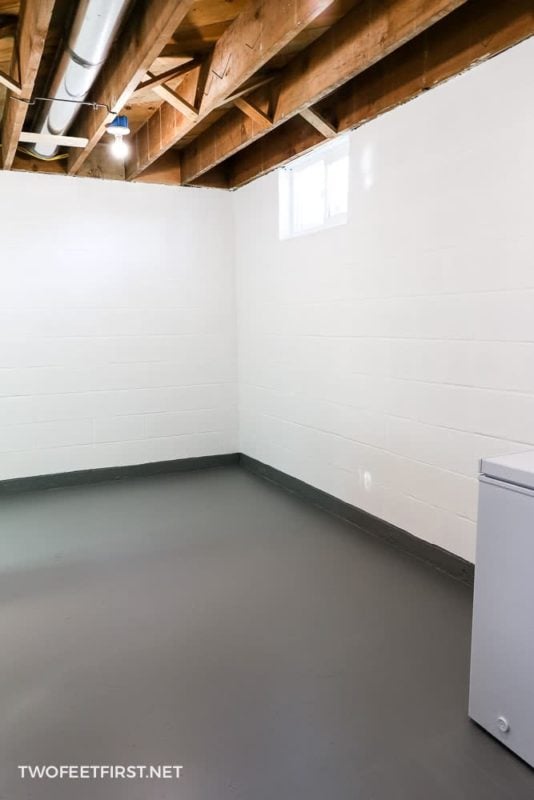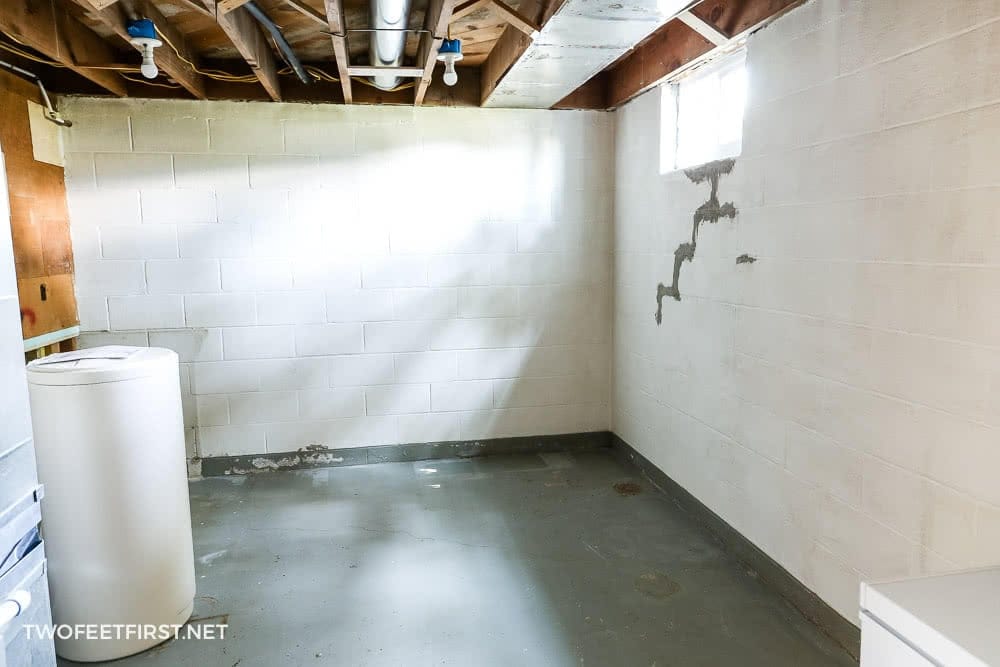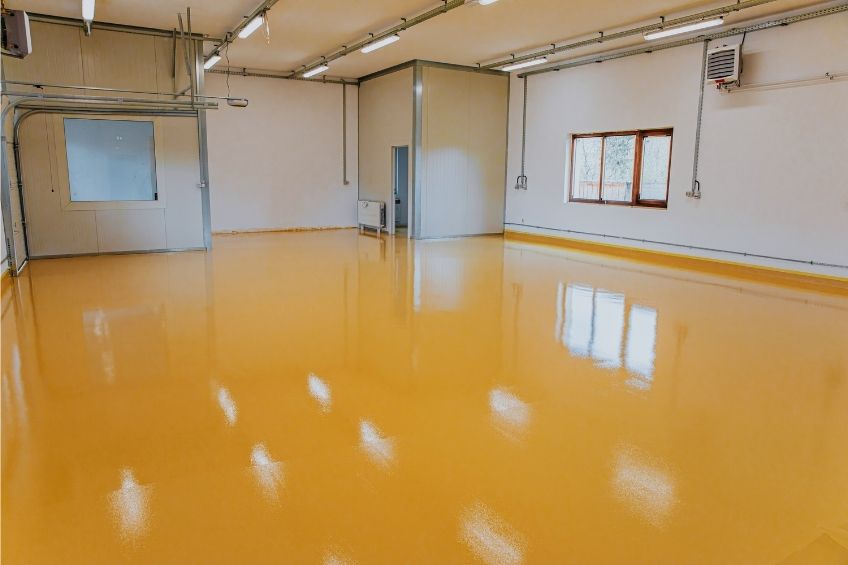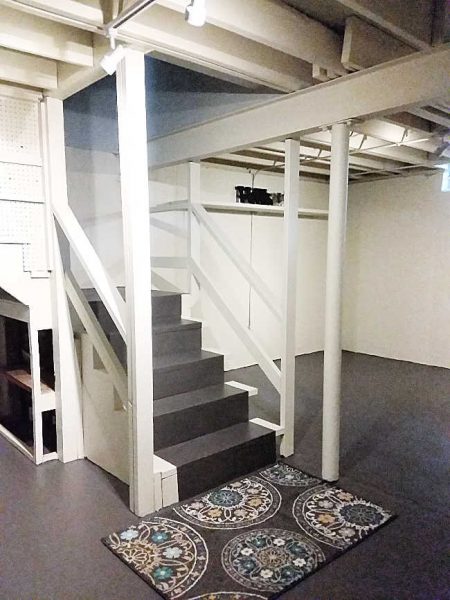Why Choose Paint for Your Basement Floor?
When it comes to finishing a basement floor, many homeowners face a multitude of choices. From tiles to carpet to laminate, the options can be overwhelming. Yet, there’s one simple and cost-effective solution that often stands out: painting your basement floor. If you’re unsure whether this option is right for you, let’s explore some compelling reasons to choose paint for your basement floor.
- Affordability That Won’t Break the Bank: One of the biggest benefits of painting a basement floor is affordability. Compared to other flooring options, paint is significantly cheaper. You can transform an entire basement floor with just a few gallons of high-quality paint, making it ideal for budget-conscious homeowners. I’ve found that this solution allows for a stylish upgrade without the high cost, which is perfect if you have other home improvement projects on your plate.
- A Quick and Easy Update: Unlike installing new flooring, which can take days or even weeks, painting a basement floor is a relatively quick process. Depending on the size of your basement, you could complete the project in a weekend. It’s a fantastic DIY project that doesn’t require special skills, and you can easily make an outdated space look fresh and new. For those of us who love instant gratification, this is a bonus.
- Customizable and Creative Design Options: With paint, the customization possibilities are endless. You can choose from countless colors and even add patterns, stencils, or textures to personalize your basement floor. Whether you’re aiming for a sleek, modern look or something more playful, painting gives you the flexibility to make your vision come to life. This creative freedom is one of my favorite aspects of using paint in a basement.
- Moisture Resistance and Protection: Basements are notorious for moisture issues, and the right floor paint can offer an added layer of protection. Special epoxy or waterproof paints are designed to resist moisture, helping to prevent mold and mildew growth. If your basement experiences occasional dampness, using moisture-resistant paint can provide peace of mind. In my experience, this is a simple yet effective way to safeguard your basement from water damage.
- Easy to Maintain and Clean: Another reason to opt for paint is the ease of maintenance. Unlike carpet that traps dust and allergens or tiles that require grout cleaning, a painted concrete floor is a breeze to keep clean. A simple sweep and occasional mop are usually all that’s needed. This low-maintenance quality is perfect for a basement that may double as a storage space, play area, or workshop.
- Long-Lasting Durability: Finally, paint can be surprisingly durable if you use the right products and techniques. High-quality floor paints are designed to withstand heavy foot traffic, making them suitable for basements used for various activities. Properly applied paint can last for years without chipping or peeling, making it a worthwhile investment. From my perspective, the combination of durability and aesthetics makes basement floor paint a no-brainer.

Types of Basement Floor Paint: Which One Is Right for You?
Choosing the right type of paint for your basement floor is crucial to ensure it looks great and lasts for years. The paint you select will depend on your basement’s specific needs, such as moisture levels, foot traffic, and your design preferences. Let’s dive into the different types of basement floor paint and what makes each one suitable for various situations.
Epoxy Floor Paint for Ultimate Durability
Epoxy paint is a top choice for many homeowners because of its incredible durability and moisture resistance. It forms a hard, thick coating that can withstand heavy traffic, making it ideal for basements used as gyms, workshops, or living spaces. Epoxy paint is also highly resistant to stains, chemicals, and impacts, which is why I often recommend it for basements that get a lot of wear and tear. Keep in mind, though, that epoxy can be tricky to apply and usually requires multiple steps.
Acrylic Paint for a Budget-Friendly Option
If you’re looking for a more budget-friendly choice, acrylic paint is a great alternative. It’s easy to apply and dries quickly, making it a go-to option for DIYers who want a fast update. While it’s not as durable as epoxy, it still provides decent protection against light foot traffic. In my opinion, acrylic paint works best in low-use areas, like storage rooms or rarely-used basements.
Latex Floor Paint for Easy Application
Latex paint is another popular choice, known for its ease of use and wide availability. It’s water-based, so it has low VOCs (volatile organic compounds), which makes it safer for indoor use. Latex paint adheres well to concrete and is great for adding a splash of color to your basement. However, it doesn’t offer the same level of durability as epoxy, so it’s best suited for spaces with minimal wear.
Concrete Stain for a Natural Look
Concrete stains are different from traditional paints in that they penetrate the concrete surface rather than just sitting on top. This results in a more natural, variegated look that showcases the texture of the concrete. Stains come in various colors and are perfect for homeowners who want an organic, rustic appearance. If you ask me, concrete stains add a unique charm that’s hard to replicate with other paints.
Urethane Coatings for Extra Protection
Urethane coatings are often used in conjunction with epoxy paint for added protection. They act as a topcoat, providing a glossy finish and extra durability. This combination is ideal for basements that serve multiple purposes, from playrooms to workshops. Urethane coatings are highly resistant to UV rays and scratches, making them suitable for basements with windows or high activity levels.
Waterproof Paint for Moisture-Prone Basements
If your basement is prone to moisture, waterproof paint is a must. These paints are specifically formulated to create a barrier against water, preventing mold and mildew growth. While waterproof paint won’t solve serious water issues (like flooding), it’s an excellent preventative measure for basements that experience occasional dampness. In my home, I’ve used waterproof paint in the laundry room area to keep it fresh and dry.
Preparing Your Basement Floor for a Fresh Coat of Paint
Preparation is key when it comes to painting a basement floor. A well-prepped surface ensures that the paint adheres properly and lasts as long as possible. Skipping any steps in the prep process can lead to peeling, chipping, or other issues down the road. Here’s a detailed guide to preparing your basement floor for paint.
Clean the Surface Thoroughly
The first step is to give the floor a thorough cleaning. Dirt, dust, and grime can prevent the paint from adhering, so make sure the surface is spotless. Use a shop vacuum to remove loose debris, and then mop the floor with a degreasing cleaner. For oil or grease stains, a concrete cleaner may be necessary. In my experience, taking the time to clean properly makes a world of difference in the final result.
Repair Cracks and Imperfections
Next, inspect the floor for cracks or holes. Concrete floors often have small imperfections that need to be patched before painting. Use a concrete patching compound to fill any gaps, and smooth it out with a trowel. Allow the patch to dry completely before moving on. Repairing these imperfections not only improves the look of the floor but also ensures that the paint wears evenly.
Remove Any Existing Coatings
If your basement floor has old paint or sealant, it will need to be removed. A floor grinder or paint stripper can help you tackle this task. Removing existing coatings creates a clean slate for the new paint to bond with. This step may seem tedious, but trust me, it’s crucial for a long-lasting paint job. Once all the old paint is removed, give the floor a final cleaning to eliminate any residue.
Etch the Concrete for Better Adhesion
Etching the concrete is an important step that opens up the pores of the concrete, allowing the paint to adhere better. You can use a concrete etching solution, which is available at most hardware stores. Follow the instructions on the label, and be sure to wear protective gear. Once etched, rinse the floor thoroughly with water and let it dry completely. In my opinion, this step can make or break your project, so don’t skip it.
Test for Moisture Issues
Before painting, it’s essential to check for any underlying moisture problems. Tape a piece of plastic sheeting to the floor and leave it for 24 hours. If condensation forms underneath, your basement may be too damp for painting. Address any moisture issues before proceeding, whether it’s through a dehumidifier or a professional waterproofing solution. Taking the time to test for moisture can save you from headaches later.
Prime the Surface
Finally, apply a primer designed for concrete floors. Primer helps the paint adhere better and provides a more even finish. Use a roller for large areas and a brush for corners or edges. Let the primer dry according to the manufacturer’s instructions before applying the paint. From my experience, a good primer sets the stage for a professional-looking paint job, so don’t overlook this step.
Step-by-Step Guide to Painting Your Basement Floor
Painting your basement floor can seem like a daunting task, but with the right steps and a bit of patience, you can achieve a professional-looking finish. It’s a rewarding DIY project that can transform your basement from drab to stunning. Here’s a detailed step-by-step guide to help you along the way.
Gather Your Supplies
Before diving into the project, make sure you have all the necessary supplies. You’ll need high-quality basement floor paint, a concrete primer, a paint roller with an extension handle, brushes for edges, painter’s tape, and a concrete patching compound if you haven’t done any pre-repairs. Don’t forget safety gear like gloves, goggles, and a mask to protect yourself from fumes. Having everything on hand will make the process smoother and more efficient.
Mask and Protect Surrounding Areas
To ensure a clean paint job, use painter’s tape to mask off areas like baseboards, walls, and any fixtures you want to keep paint-free. Covering these areas prevents accidental splatters and helps create crisp lines. Additionally, consider laying down plastic sheeting over any nearby furniture or stored items. Taking these extra precautions can save you from hours of cleanup and touch-ups later.
Apply the Primer
Once your floor is clean, dry, and prepped, it’s time to apply the primer. A concrete primer will create a strong bond between the paint and the floor, ensuring durability. Using a paint roller, apply an even coat of primer across the entire surface. Work in small sections, and be sure to use a brush for corners and edges. Allow the primer to dry according to the product instructions before moving on to painting. In my experience, a well-primed floor makes the paint adhere beautifully.
Start Painting the Floor
Now for the fun part: painting! Stir the paint thoroughly to make sure the color and finish are evenly mixed. Using a roller, apply the paint in long, even strokes, working your way across the floor methodically. It’s best to work in sections, starting from the farthest point in the room and moving towards the exit to avoid painting yourself into a corner. For the edges and tight spaces, use a brush for precision. Depending on your chosen paint, you may need two or even three coats for full coverage.
Let Each Coat Dry Thoroughly
Patience is key when it comes to painting a basement floor. Allow each coat of paint to dry completely before applying the next one. This can take anywhere from several hours to a full day, depending on the paint type and humidity levels in your basement. Rushing this step can lead to a patchy, uneven finish. I know the waiting can be difficult, but it’s worth it for a flawless look.
Seal the Floor for Extra Protection
Once you’re satisfied with the paint coverage and everything has dried, consider sealing the floor with a clear topcoat. This adds an extra layer of protection against moisture, scratches, and daily wear. A good sealer can also give your floor a beautiful sheen, whether you prefer a glossy or matte finish. Apply the sealer with a clean roller and let it cure for the recommended time before walking on the floor or placing any furniture. Trust me, sealing is a game-changer for longevity.
Design Ideas and Color Inspiration for Basement Floor Paint
Painting your basement floor isn’t just about function; it’s also a chance to get creative and bring your design vision to life. With the right color and design, you can completely transform the look and feel of your basement. Here are some inspiring ideas to consider for your space.
Neutral Shades for a Modern Look
If you’re aiming for a sleek and modern vibe, neutral colors like gray, beige, or white are excellent choices. They create a clean, minimalist backdrop that works well with any decor. A light gray floor paired with white walls and metal accents gives off a contemporary, industrial feel, while warm beige tones can make the space feel inviting. I’ve found that neutral shades are timeless and versatile, making them perfect for basements that serve multiple purposes.
Bold and Vibrant Colors for a Playful Space
For a basement that doubles as a playroom or entertainment area, don’t be afraid to go bold. Bright colors like teal, orange, or yellow can add a fun and energetic atmosphere. You can even use contrasting colors to create zones within the basement, like a blue floor for a media area and a red one for a gaming corner. Vibrant hues bring life to an otherwise dull space and make the basement a favorite hangout spot for kids and adults alike.
Dark Tones for a Cozy Ambiance
If you want to make your basement feel cozy and intimate, consider using darker tones like navy, charcoal, or deep brown. These colors can create a warm and inviting atmosphere, perfect for a home theater or a man cave. Dark floors also hide dirt and scuff marks better, which is a practical bonus. To balance the space, use lighter-colored furniture or wall decor. From my experience, dark floors paired with soft lighting can make a basement feel like a luxurious retreat.
Geometric Patterns for a Modern Edge
Geometric patterns are a fantastic way to add a modern and artistic flair to your basement floor. You can use stencils or painter’s tape to create shapes like hexagons, diamonds, or triangles in contrasting colors. For a subtle look, stick to two neutral shades, or go bold with multiple bright colors. I’ve always admired how geometric designs can turn a simple concrete floor into a striking visual statement.
Faux Tile or Wood Designs for a High-End Look
If you love the look of tiles or hardwood but don’t want to deal with the cost or maintenance, faux designs are a great option. You can paint your concrete floor to mimic ceramic tiles, hardwood planks, or even marble. With a little creativity and some painter’s tape, you can achieve a high-end look at a fraction of the price. In my opinion, this is one of the best ways to elevate a basement floor without breaking the bank.
Two-Tone or Ombre Effects for a Unique Style
For a one-of-a-kind look, consider using a two-tone or ombre effect on your basement floor. You can divide the floor into two contrasting colors for a bold statement or use an ombre technique to blend shades gradually. This design works well in basements with large open spaces and can make the room feel more dynamic. I’ve found that playing with gradients can create a calming or energizing atmosphere, depending on the colors you choose.
How to Maintain and Protect Your Painted Basement Floor
Once you’ve put in the effort to paint your basement floor, you’ll want to keep it looking pristine for as long as possible. While painted floors are relatively easy to maintain, a few simple practices can extend their lifespan and keep them looking fresh. Here are my top tips for maintaining and protecting your painted basement floor.
Sweep and Mop Regularly
Regular cleaning is the foundation of good floor maintenance. Use a soft-bristle broom or a dust mop to remove dirt and debris, as particles can act like sandpaper and wear down the paint over time. For deeper cleaning, a damp mop with a mild, pH-neutral cleaner works best. Avoid using harsh chemicals, as they can damage the paint and sealant. From my experience, keeping up with regular cleaning prevents buildup and keeps the floor looking vibrant.
Use Rugs and Mats in High-Traffic Areas
Placing rugs or mats in high-traffic areas can significantly reduce wear and tear. Doorways, workout zones, or play areas are all great places for added protection. Rugs not only preserve the paint but also add a cozy touch to your basement. I recommend choosing rugs with non-slip backings to keep them securely in place, especially if you have kids running around.
Address Spills and Stains Quickly
Even though painted concrete is relatively resistant to stains, it’s still important to clean up spills immediately. This is especially true for acidic or oily substances, which can leave marks if left untreated. Blot the spill with a clean cloth and use a mild cleaner if necessary. Quick action is crucial to maintaining the paint’s finish, and it’s a simple habit that pays off in the long run.
Reseal the Floor as Needed
If you use a sealant on your painted floor, keep in mind that it will eventually wear down, especially in high-traffic areas. Reapplying the sealant every few years can keep the paint protected and looking its best. A fresh coat of sealer enhances the floor’s durability and helps it resist stains and moisture. In my opinion, resealing is a small investment of time and money for significant long-term benefits.
Protect the Floor from Heavy Furniture
Heavy furniture can scratch or dent the painted surface if not properly protected. Use furniture pads or felt protectors on the bottom of chairs, tables, and any large items that may be moved frequently. For stationary pieces, consider using furniture sliders to prevent damage when rearranging. I’ve learned that this simple step can save you from unsightly marks and prolong the life of your floor.
Keep an Eye Out for Damage
Finally, make it a habit to inspect your floor periodically for any signs of damage, like chips, cracks, or peeling paint. Addressing minor issues promptly can prevent them from turning into major problems. For small touch-ups, keep some leftover paint on hand to quickly fix blemishes. Staying proactive with maintenance ensures your painted basement floor stays beautiful and functional.
Common Mistakes to Avoid When Painting a Basement Floor
Painting a basement floor may seem straightforward, but there are a few common mistakes that can make the process less successful. Knowing what to avoid can help you achieve a polished, long-lasting finish. Here are some pitfalls I’ve seen (and experienced) that you should steer clear of.
Skipping Proper Surface Preparation
One of the biggest mistakes is not properly preparing the concrete surface before painting. Painting over dust, dirt, or old coatings can result in poor adhesion, causing the paint to peel or chip. Always clean, repair, and etch the concrete before starting your project. From my perspective, preparation is half the battle and directly affects how well the paint holds up over time.
Using the Wrong Type of Paint
Not all paints are created equal, and using the wrong type can lead to disappointing results. Regular wall paint won’t hold up on a basement floor, so it’s crucial to choose a product specifically designed for concrete. Epoxy, latex, or acrylic floor paints are the best options, depending on your needs. Trust me, using the right paint makes a significant difference in the floor’s durability and appearance.
Applying Paint Too Thickly
It’s tempting to apply a thick coat of paint to save time, but this can backfire. Thick layers take longer to dry, are more prone to peeling, and can leave visible brush or roller marks. Instead, apply multiple thin coats, allowing each one to dry completely before adding the next. I’ve learned that patience pays off, and thin coats provide a smoother, more even finish.
Ignoring Moisture Problems
Basements are notorious for moisture issues, and painting over a damp surface can be a recipe for disaster. Moisture can cause the paint to bubble, peel, or even prevent it from adhering in the first place. Always test for moisture before starting your project, and address any issues with a dehumidifier or professional waterproofing if necessary. In my experience, skipping this step can lead to major headaches down the road.
Not Letting Paint Cure Properly
Even after the paint feels dry to the touch, it still needs time to cure fully. Curing can take several days, and walking on the floor too soon can leave imprints or scuff marks. Be patient and avoid placing furniture or heavy items on the floor until the paint has cured completely. I’ve seen firsthand how rushing this step can ruin an otherwise beautiful paint job.
Neglecting to Seal the Paint
Finally, forgetting to apply a protective sealant is a mistake that can shorten the life of your painted floor. A sealant provides an extra layer of defense against moisture, stains, and wear. Without it, your floor may not hold up to daily use. From my experience, sealing is a must for maintaining a vibrant and durable finish, so don’t skip this important step.
Epoxy Paint And Your Waterproofed Basement Floors
Paint your basement floor
Painting my Concrete Basement Floor
How to fix Concrete Floor Cracks with Epoxy
Best Basement Cement Floor Paints – Our Complete Guide
Ingenious Painted Flooring Ideas for an Unfinished Basement
Basement Concrete Floor Painting
Related Posts:












